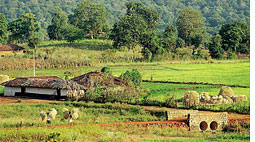First food: business of taste
Good Food is First Food. It is not junk food. It is the food that connects nature and nutrition with livelihoods. This food is good for our health; it comes from the rich biodiversity of our regions; it
Good Food is First Food. It is not junk food. It is the food that connects nature and nutrition with livelihoods. This food is good for our health; it comes from the rich biodiversity of our regions; it
Need for identification and value assessment of agro-biodiversity heritage sites in the context of recent Acts has been highlighted to facilitate conservation and evolution of sustainable agriculture.
Officials in southern China's Guizhou Province are hoping to head off future attempts at "biopiracy"--the plunder of natural resources--by enshrining the protection of indigenous knowledge into law.
In a recent perspective, "Food security under climate change" (1 February, P. 580), M.E. Brown and C.C. Funk conclude that improved seed, fertilizer, land use and governance lead to food security. I find these claims highly questionable. The green revolution model (monocultures of improved crops supported through high levels of agrochemical and other inputs) has done much to increase agricultural productivity. It does little, if anything, to increase food security. (Letters)
Plants are an integral part of life and culture. Folk songs give an idea of plants growing in the surrounding environs of tribal's and throw light on plant-based practices in usage in various spheres of their lives, including the material benefits derived and recreational opportunities offered. This article talks about the desert plants like khejri, ber and its uses.

indigenous knowledge can now be deployed for a common laboratory procedure. Annatto, a reddish orange dye, is used by indigenous people in many parts of Latin America as a cleanser of poisons.
The International Assessment of Agricultural Science and Technology for Development (IAASTD) brought together governments, internatonal organizations and private sector and civil society organizations to address the challenges of food security, food supply, food prices. The task was to assess the current state and future potential of formal and informal knowledge, as well as science and technology, (i) to reduce hunger and poverty, (ii) to improve rural livelihoods, and (iii) to facilitate equitabble, sustainable development.

Book>>Benwar Swaraj
With a rangbwtang (necklace made of silver coins) round her neck, Koyati Reang, clad in the traditional attire of a Reang woman
AS WE TURNED off the sixlane Bangalore-Mysore highway, headed down progressively narrower roads, it seemed like we were going to any other village in rural Karnataka. Ragi and horse gram were spread on the road to be threshed by passing vehicles and the paddy fields were dotted with Egrets and Black Ibis. But as we approached Kokkare Bellur, it became clear that this was no ordinary village: overhead, we saw a few pelicans and from atop several trees came the loud raucous calls of nesting storks.
Publication of annual almanac Vijayeshwar Panchang by Vijayeshwar Jyotish Karyalaya (Regd.) since three centuries in Kashmir has been constantly devoting a few pages that predict the local climatic conditions based on the astrological calculations for the year and their effect on important crops, productivity and quality. Agricultural operations in Kashmir are carefully timed so as to fall within a certain period before or after Navroj (spring) and Mezan (autumn). If the period exceeds it is sure to lead to crop failure.